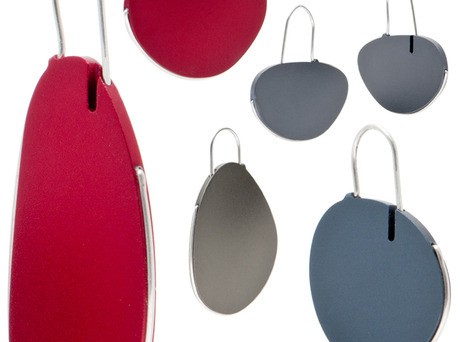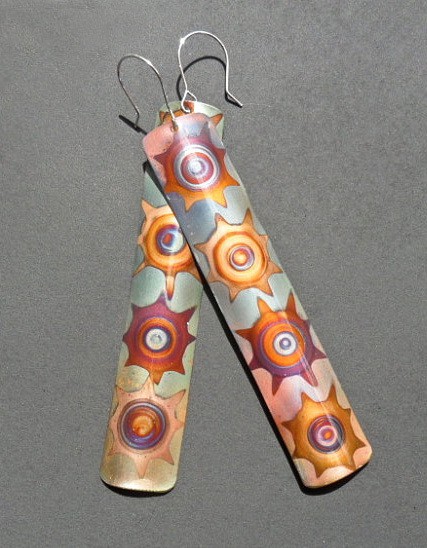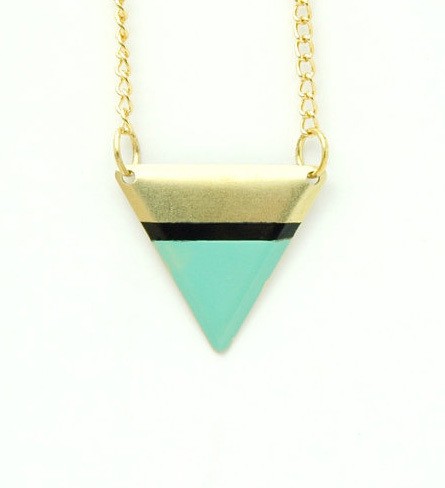This is the second part in my How-to on jewellery metals, and this one’s about the common non-precious metals used in jewellery. I’ve written it with the beginner-jeweller in mind, because I am absolutely passionate about excellence in craftsmanship, and that starts at the very beginning. Isn’t it so very satisfying when you make beautiful things? If you start with the right materials and the right tools, then you’re already way ahead of other folk.
As I said in the first post, this series has been prompted by me seeing some metals used in quite ugly ways, and it stems from my utter conviction that some materials are NOT suitable for some purposes.
Please consider this only as an introduction to the various metals – I’ve tried to keep it brief and useful, but of course in doing so, there is so much more that I haven’t talked about here! Think of this information as guidelines, rather than rules.
So let’s start.
Aluminium: In its raw form, it is light grey in colour and very lightweight. It is low in cost, it is the most abundant metal on the planet, mostly occurring in combination with other minerals and particularly as bauxite ore. It wasn’t isolated until 1825, and was considered so special then that a 100 oz pyramid of it was made to crown the Washington Monument in 1884.
- Generally, aluminium is a bit too soft for applications where the metal gets a bit of wear and tear, and in its raw form is also a bit reactive.
- It is not suitable for soldering (joining with a filler metal of a lower melting temperature), although it can be welded (joining by melting the work pieces). The most practical joining methods for the home jeweller are cold-joining methods such as screws and rivets.
- It can be shaped relatively easily. If it gets work-hardened, you can anneal it by rubbing it over with a cake of soap – when the soap turns black, the aluminium has reached the right temperature, and will be soft enough for working again.
- For me, its main attraction is the wonderful process of anodising – an electrochemical process which produces a porous surface, capable of being dyed any colour in the rainbow. The dye is translucent, which means that whatever finish you put on the metal – matt, shiny or anything in between – will shine through the colour from underneath, and can add great depth and richness to the colour.
- Anodised aluminium can be dyed in plain colours, but it can also be painted, used with resists (a coating resistant to dye), or printed – so a huge variety of colour combinations can be achieved. I featured some fabulous anodised work by Lindsey Mann on the blog recently here – she combines printing techniques with anodising to create beautifully patterned surfaces.
- Anodising also makes the surface much tougher and substantially less reactive. Although the surface can be scratched, with reasonable care it is very durable.
Nickel: Nickel is an inexpensive metal, often used for alloys, and for plating. It is light grey in colour, with a hint of yellow.
- Nickel is often used in alloys, as it is quite hard and resistant to corrosion, but is still relatively easy to work with in shaping and polishing.
- Nickel silver is the most common alloy, and is a mix of copper, nickel and zinc. Depending on the alloy, it can move around a bit when you’re trying to solder, so is not the ideal material to practice soldering techniques on.
- Because it is tough and inexpensive it is often used in jewellery findings (they’re the functioning bits of jewellery, like pin backs and earring posts)
- NOTE! Nickel is NOT good for people with sensitive skin. This is especially a problem because gold is often alloyed with nickel for colour and hardness – please check the alloy you are using.
Copper: I have to say right now that this is my least favourite metal to work with, although it does have its uses.
- In its pure form, it is orangey-pink in colour, and next to gold, is the only other metal that is not white or grey.
- Copper is very cheap, relatively soft and easy to work with, and for this reason it is great for experimenting with, and for sorting out design problems in a tangible way. It’s is my best recommendation for a practice material – hone your shaping skills and your soldering skills on it.
- Best used as a decorative element in jewellery pieces, you can utilise its reactiveness and colour it with various chemicals to achieve a wide range of colours and finishes, called patinas. Most popular is black or dark brown, easily achieved by using Liver of Sulphur (Potassium Sulphide). This will also react with the copper in sterling silver, so if you want to contrast blackened copper against silver, use pure silver, or else be prepared to work the black off the 925 silver with emery. You can also oxidise it through heat, as in the earrings above.
- NOTE: Copper reacts with your skin very easily. When fresh, the metal is a soft orangey-pink, but readily discolours to a dull dark brown. More than that however, it can leave unpleasant residues on your skin, which on some people can be a dirty green. There are some who advocate its anti-arthritic properties, but for goodness sakes PLEASE don’t use it for earwires! It makes my skin crawl to think about it. That includes those things with fancy coatings that supposedly stop its reactiveness – they can wear off.
- Be careful with patinas! Yes, there are lots of pretty colours you can get with copper because it is so reactive, but many of the patinas are also not good near skin, and in some cases are downright toxic. Please do your safety research before using them.
- I had a very hard time trying to find a picture of a piece of jewellery that uses copper well. Most of the copper ‘jewellery’ I found looking though Etsy needs to be tossed in the bin. Enough said.
Brass: Brass is an alloy of copper and nickel, and for the most part, I have the same opinion about brass as I do copper. It is goldish in colour, but has a hint of green to it, and lacks the luminosity and warmth of gold.
- It’s a bit harder than copper, but still great for learners to hone their skills on.
- It can also be coloured with patinas
- It reacts with skin readily – do NOT use it for jewellery that sits against the skin.
- Brass looks best on door knobs, house name-plates and fireplace tools.
*
In summary, use brass, copper and nickel mostly for practising with. You can utilise them in jewellery, but use them with caution – the more you practice and grow your jewellery-making skills, the more readily you will be able to make wise decisions about when and where to use them.
Anodising aluminium is great fun and relatively easy, but it does require lots of acid and a bit of equipment, so is probably not for the beginner.
Use sterling silver where you can – simple pieces can look great in this lustrous white metal, and it’s very nice to work with. If you muck something up, you can always melt it and use the silver again. Importantly, it is fine for the majority of the population to wear against their skin (although there are still some people with sensitivities). You can add colour with precious or semiprecious stones, enamel, and other things. Skills and imagination can take you many places.
High karat gold is even lovelier to work with, but is mostly out of the price range of the beginner jeweller. If you continue your practice in a consistent manner, developing your skills and your ideas, you will know when you’re ready to try gold.
My fondest hope is for the world to be a prettier place. Beauty makes us happy, and that surely is a good thing. And I love that handmade is riding a wave at the moment! I want everybody to experience the joys of making things, but I also want people to understand that beautiful work takes time, much skill and understanding of tools and materials.
I would love to hear about what you’ve been making! Feel free to drop me a link in the comments below.
Happy making,
Julie 🙂
***
(The link to the first part of this post, covering precious metals, is here.)



